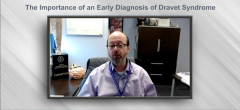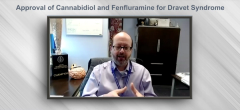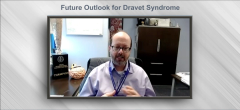
Treatment Options for Dravet Syndrome
M. Scott Perry, MD, discusses historically approved therapies for the first-, second-, and third-line treatment of Dravet syndrome.
M. Scott Perry, MD: How can you treat once you know a child has Dravet syndrome? As I said, there are certain treatments that are likely to be more successful. In the past and until just the last couple of years, there was really a triumvirate of medications that we often considered, mostly based on expert opinion, that being clobazam, valproic acid, and stiripentol. Neither clobazam nor valproic acid have had trials specific to Dravet syndrome, but as I said, through expert opinion they were felt to be very effective.
Both have GABA [gamma aminobutyric acid] mechanisms, so working in the inhibitory system, it made sense they’d be useful for Dravet syndrome. Most of the data we have about them are retrospective reviews of experience with the medication, with responder rates—or greater than 50% reduction—probably around 30% or so for clobazam; some studies report 25% to 50% for valproic acid. Stiripentol is a medication that was really the first to have a placebo-controlled trial specific to Dravet syndrome.
That was done in Europe, and in those trials, they showed that a reduction of convulsive seizures was on the range of about 69%, 70% in people who took the stiripentol. Importantly, in those trials all the patients were on valproic and clobazam. We know that clobazam levels, for example, elevate in the setting of stiripentol, so there is some play of not just stiripentol as a primary medication, but the elevation of clobazam also likely contributing to some improvement.
As a result, a couple of years ago, stiripentol was approved in the United States for the treatment of Dravet syndrome in children ages 2 and older when used with clobazam. That’s an important thing for people to be aware of, that that is the indication here. There is a variety of other treatments that we would really consider second- and third-line treatments for Dravet syndrome, and basically that field is antiseizure medications that don’t have a sodium channel mechanism of action.
They’re all fair game. For instance, topiramate is commonly used. I always caution people with the topiramate, while I think it is a good medicine, it does result in decreased sweating and thus increases the risk for overheating, which we already know is a risk factor in this population. It can also, of course, decrease appetite. The ketogenic diet is commonly used. Studies of the ketogenic diet and Dravet show response rates in the range of 40%, 50%, as we see in some other epileptic encephalopathies in that treatment.
Levetiracetam and zonisamide are commonly used. Ethosuximide, as I said, a lot of these kids have absence or atypical absence seizures, so ethosuximide can be very helpful for that specific type. Vagal nerve stimulation has been another nonmedicinal approach that people have used for the treatment of Dravet syndrome with some success.
Newsletter
Keep your finger on the pulse of neurology—subscribe to NeurologyLive for expert interviews, new data, and breakthrough treatment updates.


























